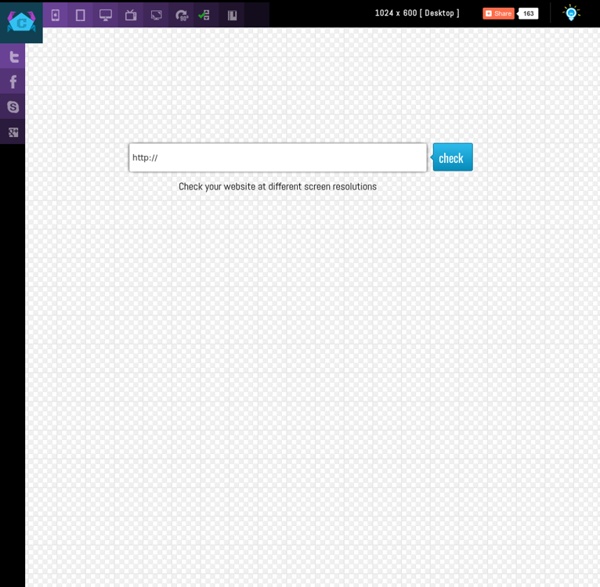



Responsive Templates - Media Queries Responsive Web Design With Physical Units Advertisement This post should be titled “Getting Ahead of Yourself.” “…By a Few Years,” actually. Here’s the deal: at the time I’m writing this, early 2013, there’s no way to accurately design for the Web using physical units, nor will there be for a very long time. But there is a way to design while knowing the physical characteristics of the device — or, at least, there will be in the very near future. Different devices can have a similar screen resolution, yet entirely different physical factors. iPad (1st generation) has the diagonal size of 9.7″, the resolution 1024 × 768 and 132 ppi. It’s called the “resolution media query”, and it’s been in the specification for media queries for some time. The Thin Line Between Queries First off, I posit that there will be only one use case for a resolution-only media query. @media (min-resolution: 250dpi) { } has, at this time, only one good use: swapping out low- for high-resolution images. Good. Let’s compare two media-query declarations: and
SEO Browser Article: 3 Free Apps for Testing Your Responsive Designs Online Responsive design has brought about a whole new list of challenges for web designers who have decided to take the plunge and leave static design behind. Creating a layout that works well at not one but several, or even all, possible widths requires patience, creativity and of course, lots of testing. Nothing replaces checking out your design on the actual devices that you’re targeting, but as you’re building, it’s nice to be able to get a quick peek of the layout at various widths right on your computer. Wait, Why Do I Need These? If you’re new to the concept of responsive web design, then you might be confused about why the following utilities are helpful. To pull this off, you of course need to be able to see your layout at several different widths. The Responsinator The Responsinator is probably the easiest way to get a quick look at your layout on popular device widths. To get started, all you have to do is type in the URL of a website that you’d like to test. Responsinator Pros
CSS Media Queries for iPads & iPhones | Stephen Gilbert iPad Media Queries iPad Media Queries (All generations - including iPad mini) Thanks to Apple's work in creating a consistent experience for users, and easy time for developers, all 5 different iPads (iPads 1-5 and iPad mini) can be targeted with just one CSS media query. The next few lines of code should work perfect for a responsive design. iPad in portrait & landscape @media only screen and (min-device-width : 768px) and (max-device-width : 1024px) { /* STYLES GO HERE */} iPad in landscape @media only screen and (min-device-width : 768px) and (max-device-width : 1024px) and (orientation : landscape) { /* STYLES GO HERE */} iPad in portrait @media only screen and (min-device-width : 768px) and (max-device-width : 1024px) and (orientation : portrait) { /* STYLES GO HERE */ } iPad 3 & 4 Media Queries Retina iPad in portrait & landscape @media only screen and (min-device-width : 768px) and (max-device-width : 1024px) and (-webkit-min-device-pixel-ratio: 2) { /* STYLES GO HERE */}
IE NetRenderer Adobe Edge Inspect CC - Cross browser testing Download Edge Inspect on your computerInstall the Google Chrome browser extensionDownload the extension from the Chrome Web StoreInstall the mobile client on your devicesiOSAndroidKindle Fire Edge Inspect is an essential application for web developers and designers who need to preview their content across multiple mobile devices. Wirelessly pair multiple iOS and Android devices to your computer, grab screenshots from any connected device, and see real-time results from changes to HTML, CSS, and JavaScript. Article: 10 Helpful Resources for Testing Responsive Web Design | Vandelay Design Testing is a critical part of the responsive web design process. The purpose of using a responsive layout is to make the website useful on any type of device, but without extensive testing it’s not possible to know for sure how the site is behaving in different situations. Fortunately, there are a number of different tools and resources available that can help you to test your responsive designs. In this article we’ll take a look at some helpful tools that you may want to try for yourself. Viewport Resizer Viewport Resizer works as a bookmarklet. jResize Plugin jResize is a jQuery plugin for one-window responsive development. Screenqueri.es With Screenqueri.es you enter the URL and then you can pull the slider to adjust the screen width of the display. responsivepx With responsivepx you will enter the URL and then use the sliders to set the width and height for testing. resizeMyBrowser resizeMyBrowser allows you to choose the dimensions of your browser for testing. BrowserShots Litmus